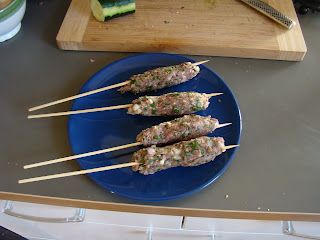
3 medium-sized beets
1/2 bunch kale
2 portabello mushrooms
1 shallot
4 cloves garlic
1 bunch dill
3-4 tbsp Greek yogurt*
3 pita bread pockets
Cut the tops off of the beets and add to a pot of salted, boiling water. Boil for 20-30 minutes or until cooked. Drain the beets and let them cool. When they have cooled, peel off the skin and set them aside.

Dice the washed portabello caps into small cubes. Finely dice the shallot. Tear the kale leaves away from the tough stem into bite-sized pieces. Finely mince the dill and garlic, separately. Add some olive oil to a skillet on medium heat. When the oil is hot, add the mushrooms. Season with salt and pepper. When they have browned, lower the heat and add the shallots. If the mushrooms have soaked up all of the oil, add a dash more. When the shallots are translucent, add half of the garlic. After about a minute, add the kale pieces. As the kale is wilting, grate the beets into the pan using a box grater.
Preheat the oven to 350 F and warm the pita bread for 3-4 minutes. When the kale appears cooked, roughly 5 minutes after adding to the pan, turn off the heat. Add the remainder of the garlic and the yogurt. Add the yogurt one tablespoon at a time and mix thoroughly. Add yogurt until the magenta, paste-like substance has a pleasing consistency.
Spoon the mixture into the warmed, halved pita bread and serve immediately.

*I really dig Fage brand Greek yogurt. Usually, when eating yogurt just for the purpose of eating yogurt, I have the full fat stuff with some honey. In this case, I went with 2% to keep it lighter.
**I would definitely try adding some feta to this concoction in the future.










































